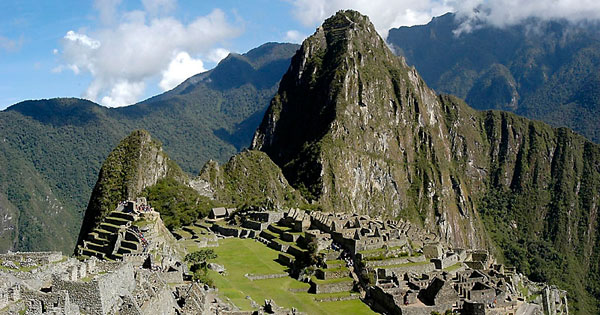
|
November 2004 Cusco and Machu Picchu and featuring the Inkaterra Machu Picchu Pueblo Hotel in Aguas Calientes. Wow! Hiking up the trail that leads to The Postcard shot. This isn't even it yet! |
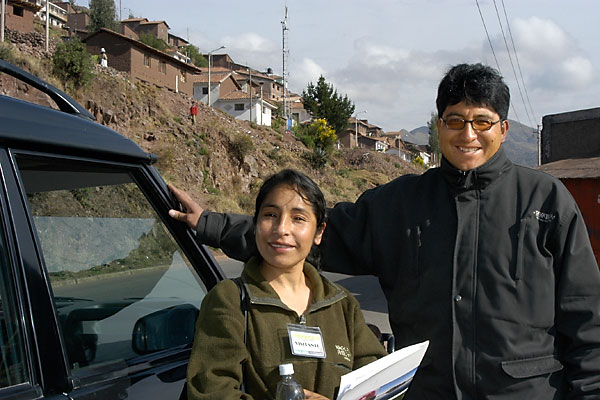
|
A representative from Inkaterra, the company that made all the arrangements for my hotels, tours and transfers in Peru, and the guide who took me onward were right there at the airport luggage pickup as agreed. Everyone connected with Inkaterra is quite wonderful as you will soon see and you can easily make personal arrangements by clicking here at Inkaterra or write me an email and I'll help you. |
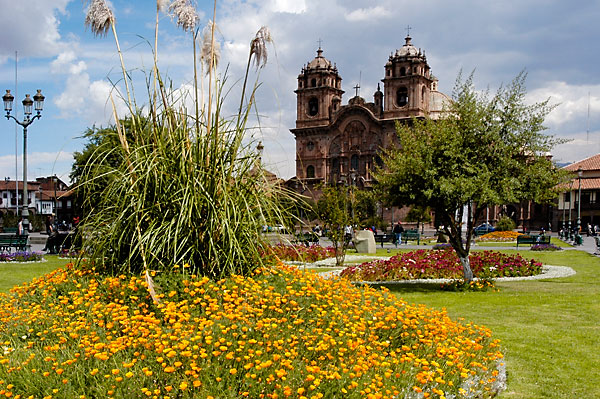
|
In the main plaza at Cusco. The town is the central kick-off point for, basically, all tourists in Peru including all the backpackers preparing to undertake the Inca Trail to Machu Picchu. Later in the trip I spent two days here and have more pictures and stories about Cusco in that section. The guide books recommend you leave Cusco as soon after arriving as possible, do your other touring and then return to Cusco as a way to lessen your chances of feeling altitude sickness since Cusco is at a higher elevation than the other tourist destinations including Machu Picchu. I was quite energetic, read up-down-up-down where I constantly saw myself as a long toothed Mountain Goat, and was quite ok with the altitude, which I attribute to the coca leaf tea! |
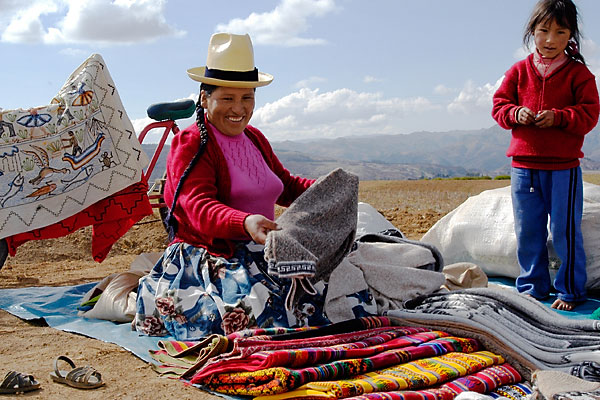
|
The whole transfer process was perfectly smooth and very soon I and the guide were off for some sightseeing on the way to catch the train for Aguas Calientes, the town at the foot of Machu Picchu. A majority of the women and men I saw along the road were dressed just like this and that hat - for real. Although this woman was set up to attract tourists, most everyone else over the age of 40 was similarly dressed. And the Hats, wow, of this type, the felt bowler style, the flat topped kind every one of them fabulous. Wow. |
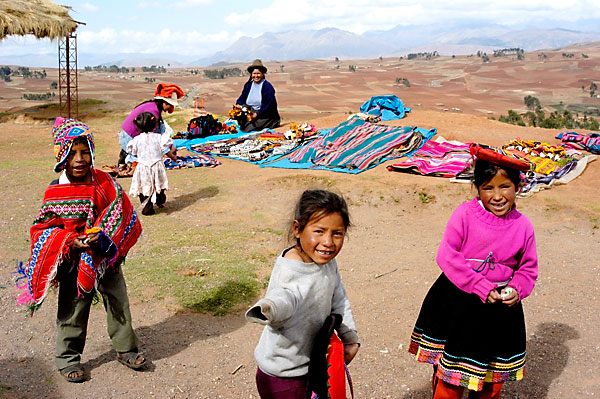
|
For the woman above, these were her competition across the street. The guide carried a bag of candies as well as small coins which he distributed to every stretched-out hand. Also all along the way he bought fresh food from people he knew to pass out to other people he knew and especially to give to anyone who did us a favor. Always having snacks on hand, I tried this a few times when I was by myself, offering to share food with folks who had gone out of their way for me, and always the offer was accepted with kind enthusiasm and led to my only successful attempts to communicate in Spanish. There must be more to this than I know! |
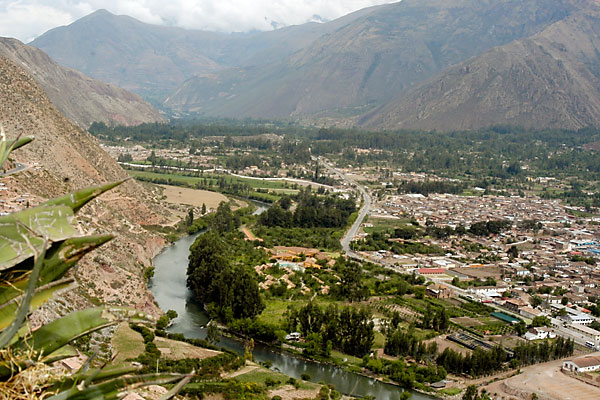
|
The drive to the train station took us from Cusco through the Sacred Valley. This is an interesting website from Cusco and I've copied this quote: 'The Sacred Valley of the Incas was undoubtedly a key area of settlement to the Incas. Its agreeable climate and fertile plains make a rare and fruitful combination for the high Andes. It was also the route to the jungle and therefore an area with access to the fruits and plants of the tropical lowlands. The Sacred Valley served as a buffer zone, protecting Cusco from incursions of the Antis, the fierce jungle tribes who from time to time raided the highlands. 'Today the Sacred Valley remains a lush agricultural region supplying the city of Cusco with much of its produce such as maize, fruit and vegetables. 'Generally the Sacred Valley refers to the section of the Vilcanota River valley between the village of Pisac and Ollantaytambo. However if you take an organized tour of the Sacred Valley you will usually visit the village of Chinchero on the way back to Cusco.' |
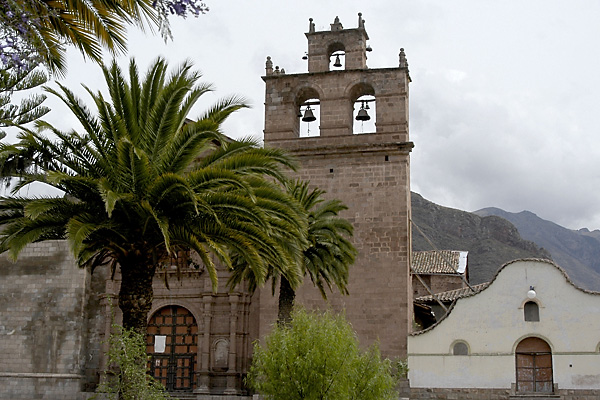
|
http://www.wheretheheckismom.com/week.asp?e=76&size=big |
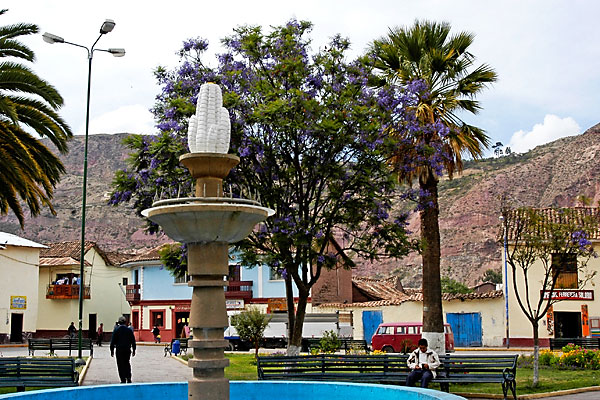
|
A monument to corn! The guide didn’t know the name of the purple flowered tree (even though I told him…) so he went around asking everyone in the plaza and no one knew. It was quite hysterical really and we all ended up laughing and knee slapping as the guide went from person to person, not one of them able to identify this prominent feature of their town. |
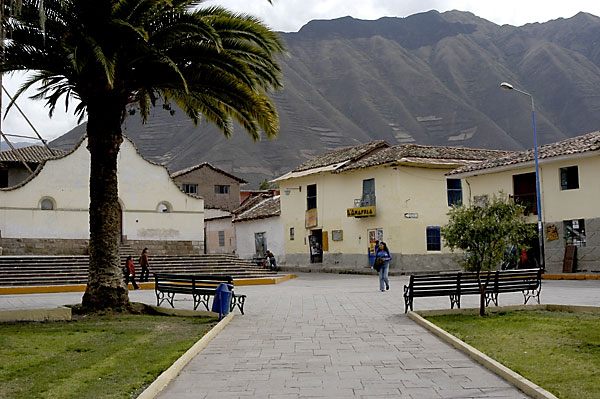
|
More of the plaza. |
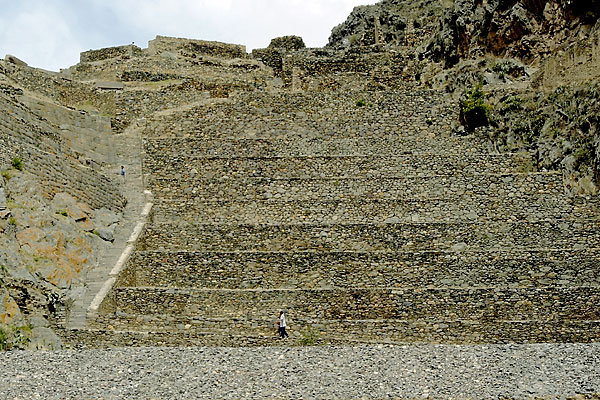
|
We were now on to Ollantaytambo to see some Incan ruins and visit with the guide's friends. Those terraces are what you see everywhere Incas built, used for moving about, grazing animals, and for crops. It's steep and high and every day I was grateful to be able to still get around. After a few days in Peru you'll have achieved some serious calf definition. |
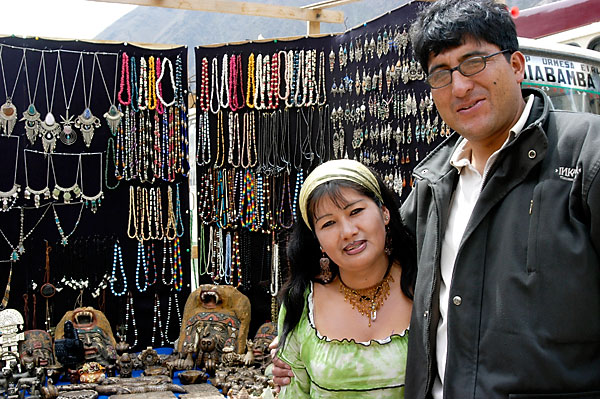
|
My guide and one of his friends at the tourist market in Ollantaytambo. |
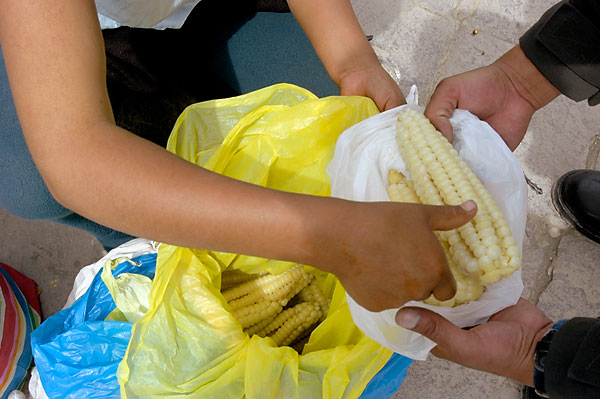
|
This is a full grown woman's hand. Check out her thumb. Then check out the size of those kernels. A row of vendors were sitting on the steps of the plaza and my guide asked if I was hungry. Of course, I replied. So we ate the most delicious food of my entire trip. This was plain steamed corn and with it you ate a square of soft and salty cheese retreived from a different bucket tended by the vendor sitting on the next step. A bite of corn and a bite of cheese, then corn, then cheese. I can taste it now. |
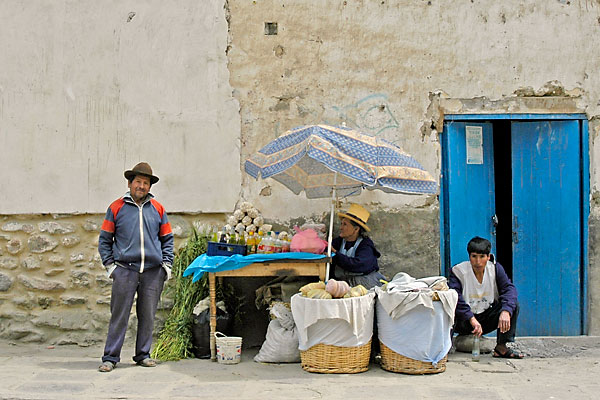
|
Another scene in the plaza. Click here if you want to read about potatoes. |
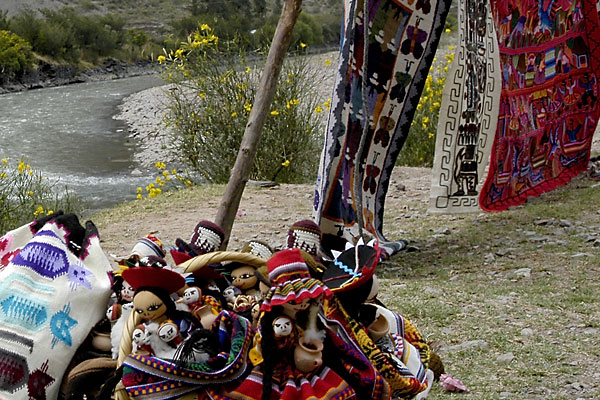
|
We are now at a wide spot in the road, beside the Urubamba river. The road leading to the train stop in town had been flooded out, cars couldn't get to the station so the train had to stop here, just by the side of the road. All the guides and bus drivers seemed aware of this as a large crowd had gathered. I was then instructed several times. 'When you come back, do not get off in town. Get off here. Don't forget. I'll be waiting for you here.' |
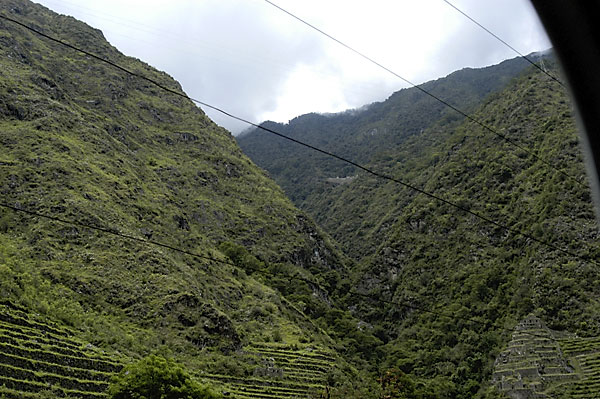
|
A view from the train. The train had been traveling steadily downhill. Cusco is over 11,000 feet in elevation and you end up closer to 12,000 before beginning the decent. Machu Picchu is at 8,500 feet and my hotel, the fabulous eco-property, the Inkaterra Machu Picchu Pueblo Hotel in Agua Calientes is at 6,600. Note the terraces in the foreground and in the high far distance you can see another set of Incan ruins. |
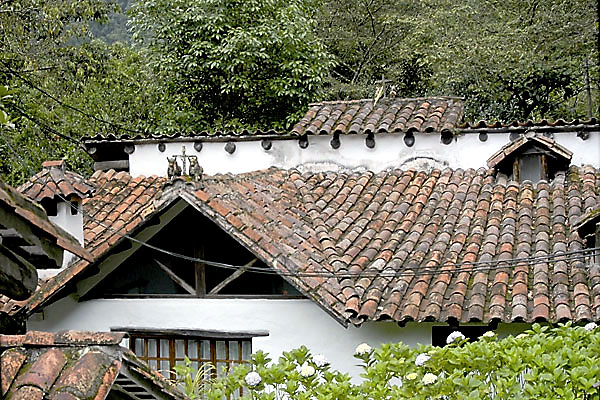
|
From my window at the hotel. I arrived in the rain and had to climb about, oh, 293 steps to get to my room and was feeling none too happy about it at the time but as soon as I could dry off, have a cup of tea and a look around I realized what a fabulous place this is. See the bulls and the crosses on the roof. They are on roofs here, in Cusco and in the surrounding countryside. At the hotel they said they are meant to be a message to God, thanking Him for keeping them and this building safe during a past earthquake and asking for continued protection. Earthquakes are a big deal both in Chile and Peru. |
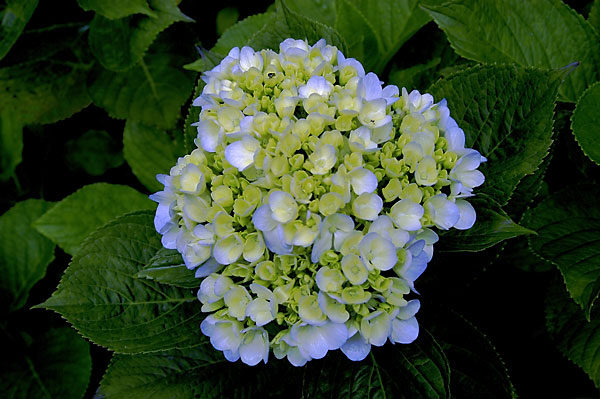
|
The landscaping around the hotel is one of the many features of which they are justly proud. From the Inkaterra brochure, they say 'Inkaterra is a Peruvian organization that has promoted and practiced innovative sustainable tourism since 1975. 'Through exploration, research and environmental conservation, as well as proactive interaction with local residents, Inkaterra seeks to protect and promote the most fascinating, magnificent, places in Peru.' |
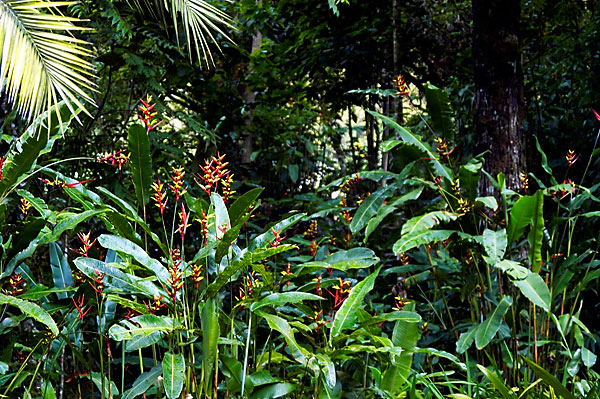
|
And regarding this property: 'Machu Picchu Pueblo Hotel is a true ecological hotel designed in accordance with boutique hotel standards. Surrounded by lush vegetation and rich biodiversity, the hotel is located in the heart of the Machu Picchu Historical Sanctuary.' These are Peruvian Bird of Paradise. |
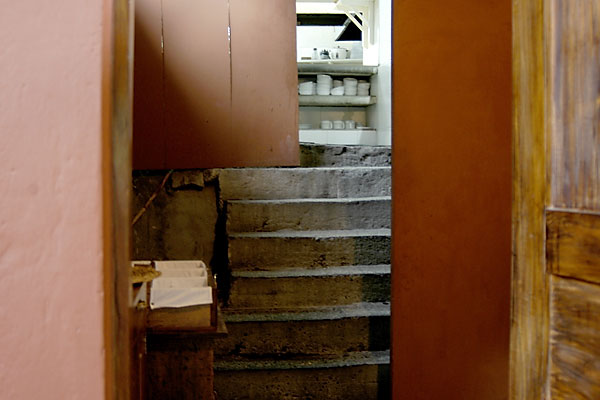
|
This picture is for Darryl and Cynthia and everyone else who has ever worked food service. The kitchen is up these stairs. I'm standing in the dining room. The servers were up and down over and over and over. It is not a union gig. |
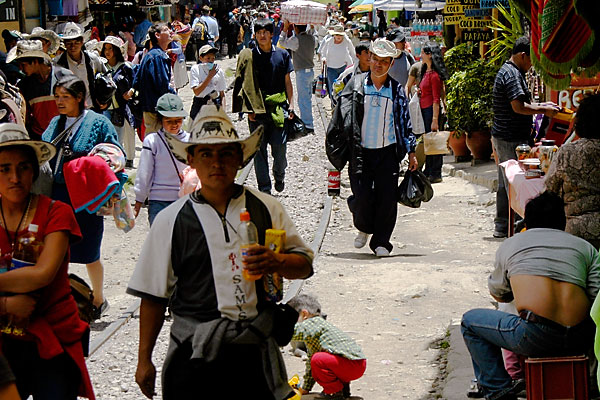
|
A scene from Aguas Calientes. |
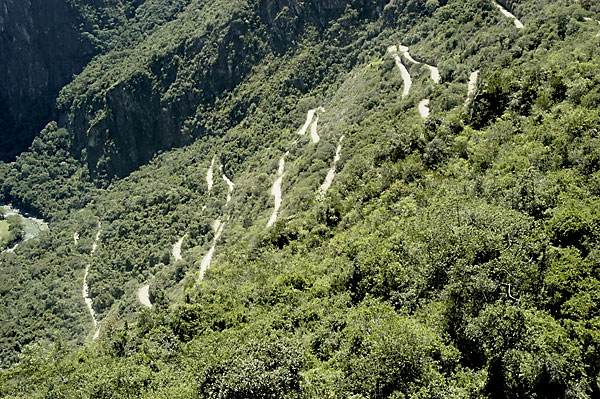
|
I was up at dawn so I and my guide could catch the 6:30 first bus up to Machu Picchu. You could take the bus or walk but I didn't see any private vehicles. This is the road. |
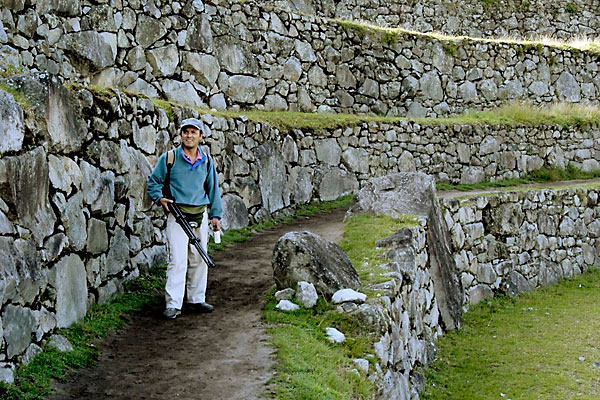
|
And here is my guide. When I think about Machu Picchu or see it in my mind, I hear his voice. This guide was able to share his sense of the spirit of the Incas, what they believed and how they lived and put these feeling as an overlay onto Machu Picchu. He answered every question with what I took to be a well read, thoughtful, and heartfelt response. It is a large and complicated place and from all accounts no one really knows much about the purpose or use. We know this is true because the 'true story' has changed many times since its rediscovery in 1911. I know if I had been tromping around here by myself or just listening as part of a group it would have been a much different experience. |
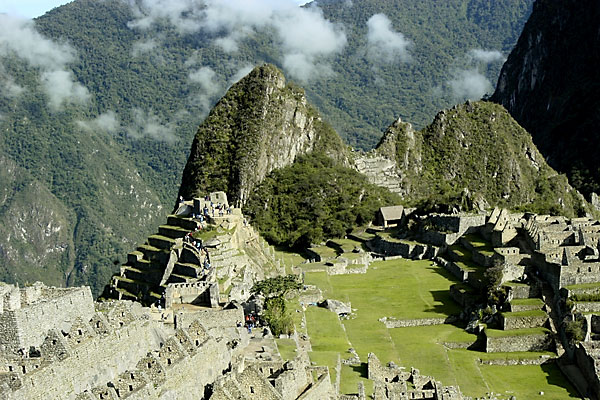
|
On the way to the postcard view. On the left side, in the middle distance, you can see a lot of stairs leading to a platform made from a giant rock. This rock is supposed to have magical powers and a lot of backpackers were gathered around hovering their hands just above the surface of the rock, to feel the vibrations from the center of the earth. |
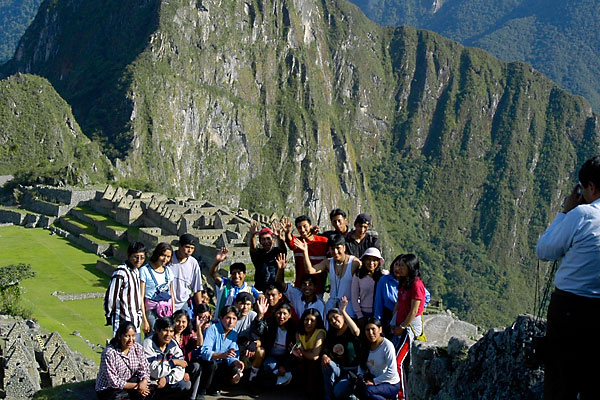
|
Local tourists. Get There Early! If you come past 11am it will be much more crowded and the sun overhead is brutal. |
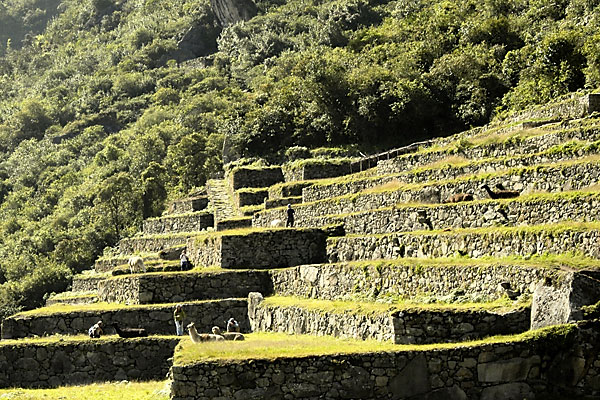
|
Llamas. |
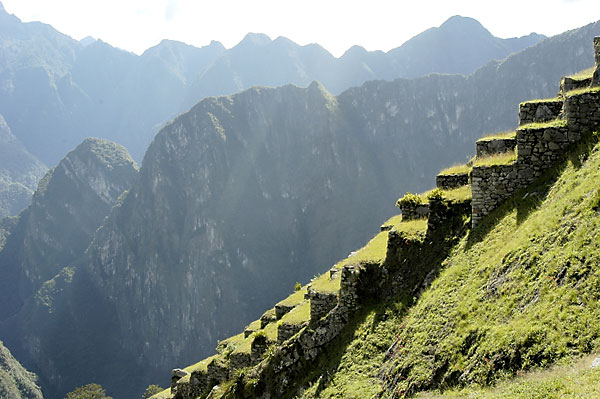
|
You can get some feeling for the majesty of the location. |
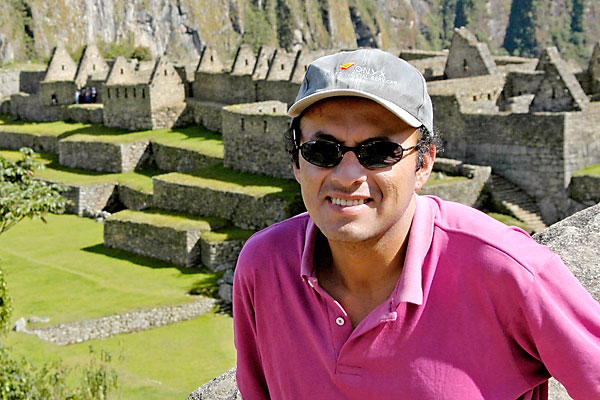
|
Here and for the next few slides are the guide's thoughts: The Incan cosmology says that life on earth is just a transition between what came before and what will come after and death in this life is simply the inevitable movement to the next stage of life. Their symbolic representation of this concept is the snake who brings us up from our past in the earth, the puma who is with us throughout this life, and the condor who flies us off to the future. The site is divided by what modern archeologists name for the supposed purpose of the buildings. The sections are temples and living space for priests, royal accommodation, workers spaces, jail. It's all pretty speculative because there is nothing in any record from the time the city flourished to say what was the purpose of the city. |
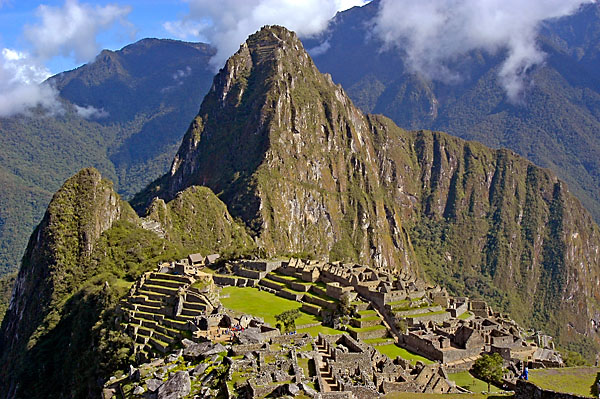
|
I asked the guide 'please take me to the postcard' and here it is! |
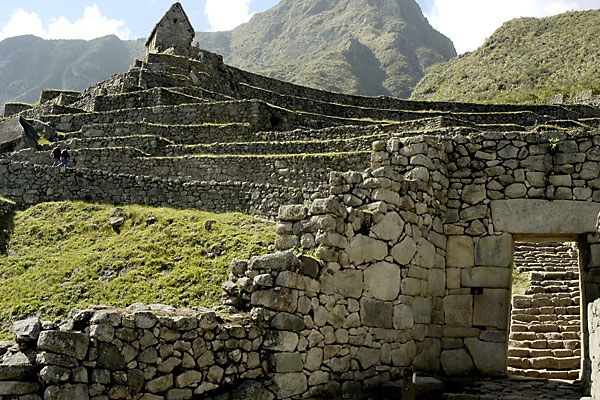
|
Like in the Mayan construction in Yucatan, the Incas didn't use arches and so were limited in their ability to create open spaces inside a building. |
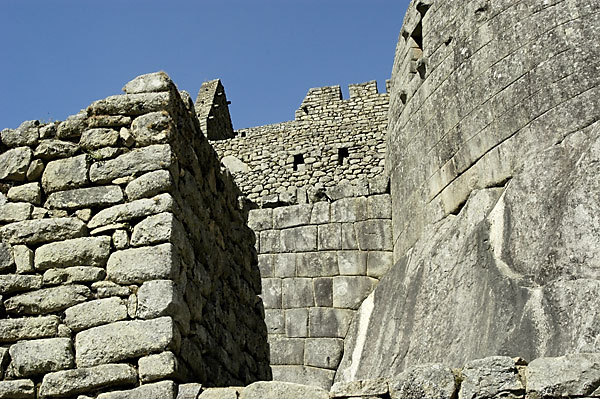
|
Notice the rocks here. There is symbolism in the size and smoothness of the stones. The more important the place the bigger the rock with which it is built. The worker's huts are constructed with pebbles and the great worship sites are single slabs of stone. What they thought about crime and punishment: Punisment was the sole perview of this world. Here in this world is where you were made to suffer for your worldly sin. Dying in any case is not a problem because everyone, no matter the sins they committed in this life, is gathered up by the condor for the next phase of life so if the punishment happened to bring death, or you died in battle, your enemies would make all the formal arrangements for your speedy passage. |
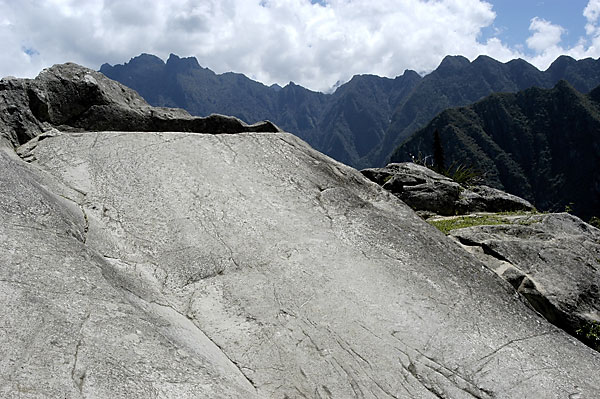
|
Above this slab is a place that could have been a sacrificial site. Indeed the Incas engaged in human sacrifices and many other bloody rituals. The sacrifices were meant to say hey, Lord of the Universe, we offer to you only what is the very best of us. |
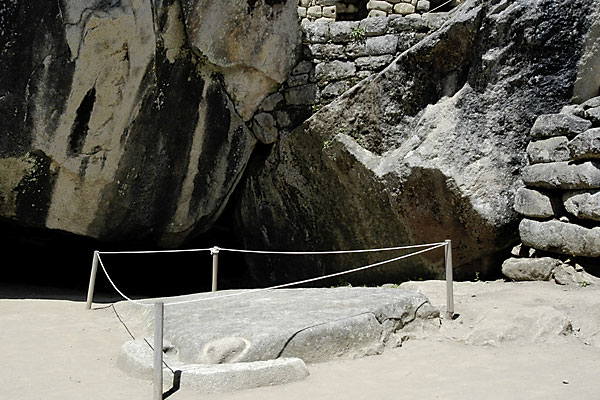
|
You can see here the head of the condor in the roped off area. His wings are represented by the slabs of rock above him. |
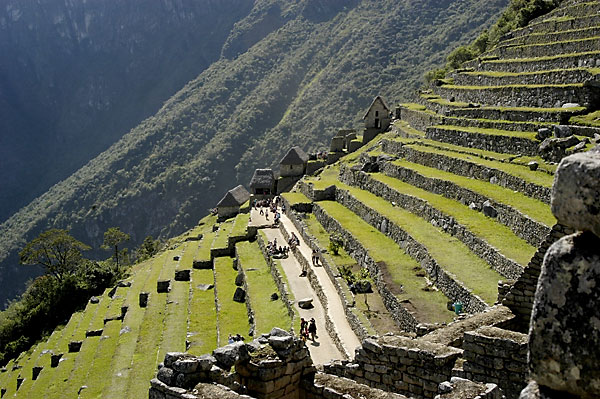
|
These terraces could have been used for growing crops. I guess you've got the idea about the omg-not-another-step?! feature of visiting Machu Picchu. There is a very small reception area, restaurant and a hotel near the entrance to the site and it is there that you catch the bus back to Aguas Calientas. |
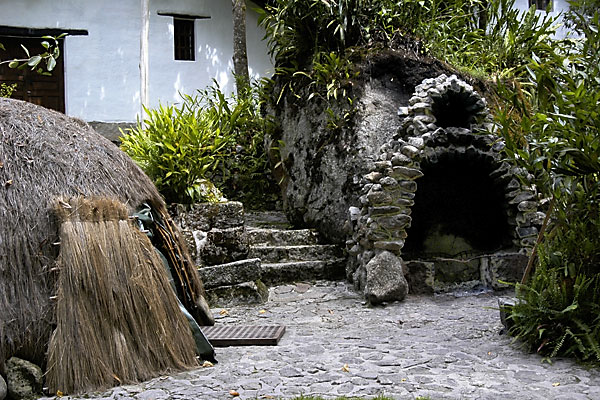
|
Back to the hotel for an Andean Sauna, just the thing after hours of up and down and up and down and up... Gotta try that for some muscle relief. You have to sign up a few hours in advance because the whole process takes two guys pretty much devoted to making this happen. First they make a fire in that fireplace like thing and heat up a lot of big rocks. Then they move the rocks into the hut and close up the door with you inside. Then they wait until you want to come out! |
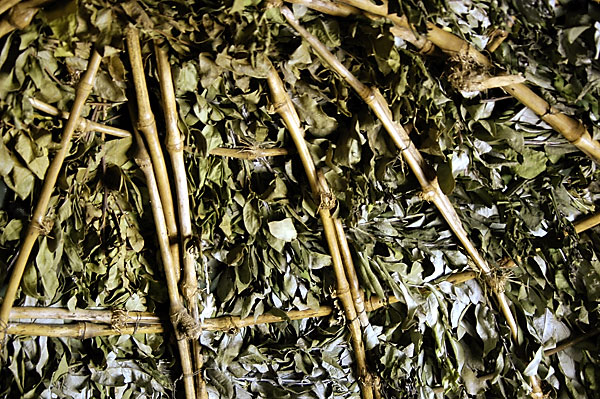
|
The hut itself is this bamboo frame covered with eucalyptus branches. You are always either by yourself or with your own companion so you can slip out of the robe they sent to your room in advance of your time and sweat away. But here's the cool part... |
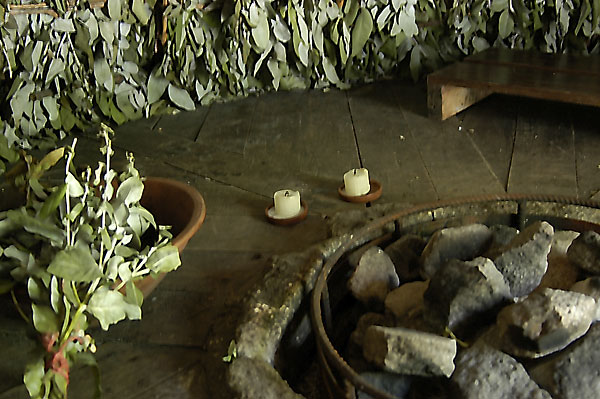
|
...it's pitch black in there except for the warm yellow glow of the candles and the red-orange glow of the rocks. You lie on a wood bench a few inches high, your robe a pillow, the ground moist wood, and with that eucalyptus branch you splash water on yourself and on the stones. It was hot but amazing, the look was beautiful and the fragrance induced the most fanciful dreams. |
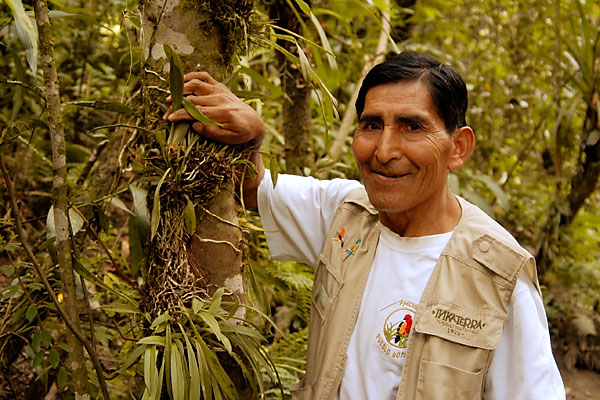
|
The hotel occupies a twelve-acre cloud forest. The highlight of the gardens is the orchid trail - maybe a mile winding around the property, with hundreds of orchid species gathered from the neighboring mountains by this guy himself. He then planted them all at eye level so they are so easy to enjoy. Very cool. The one he is revealing now he discovered and named after the owner of Inkaterra. Not after himself or his wife or his children but after his employer...without whom, he proudly reports, arms spread wide, he would not have been able to do 'all this'. |
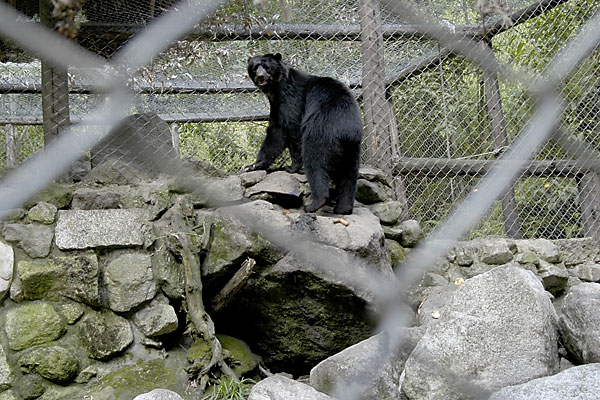
|
Another one of the Inkaterra projects is to protect and expand the habitat of the Andean bear. I can't remember if this guy was abandoned or hurt or if they are breeding. |
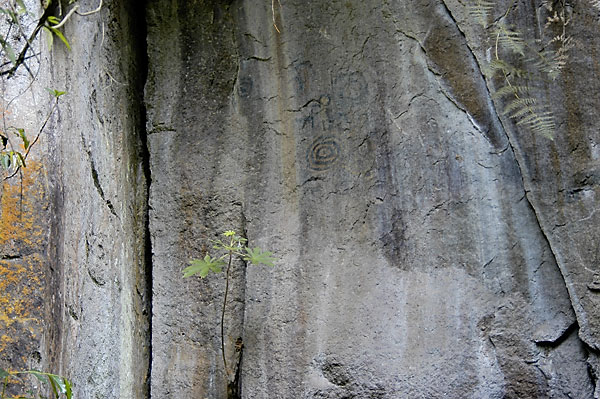
|
Rock markings. |
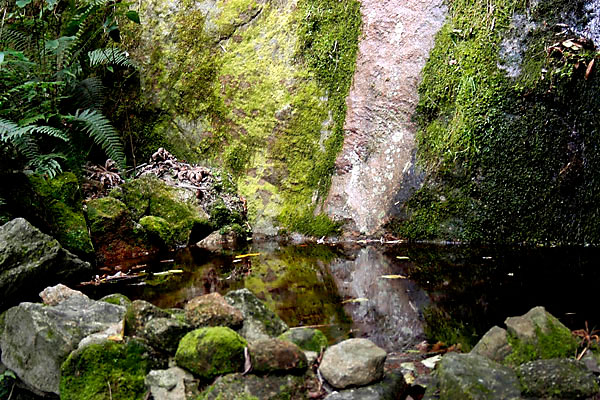
|
And a pond along the way. |
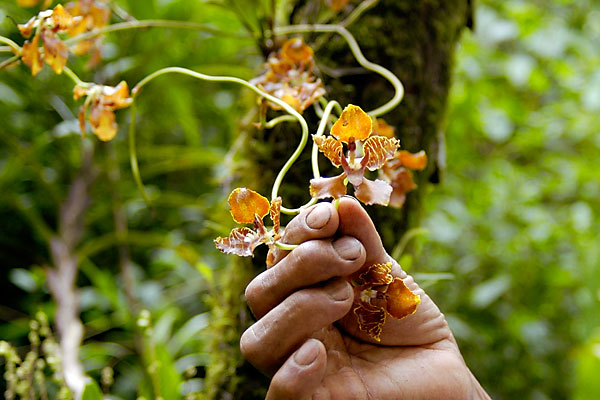
|
There are hundreds of orchid species growing here but only a small number are blooming at any one time. Remember how they are all at eye level. What fun. |
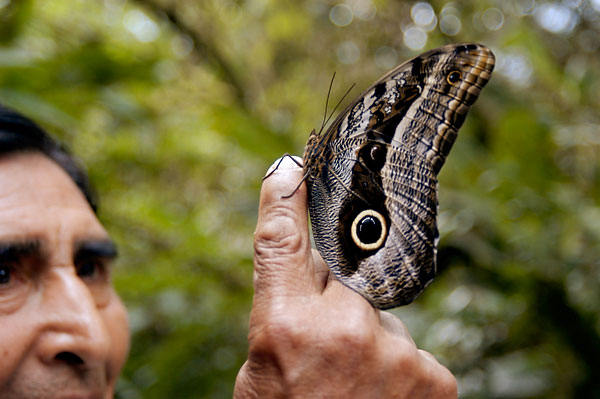
|
Inkaterra Machu Picchu Pueblo Hotel has its own butterfly breeding program to keep all the varieties of orchids happy. |
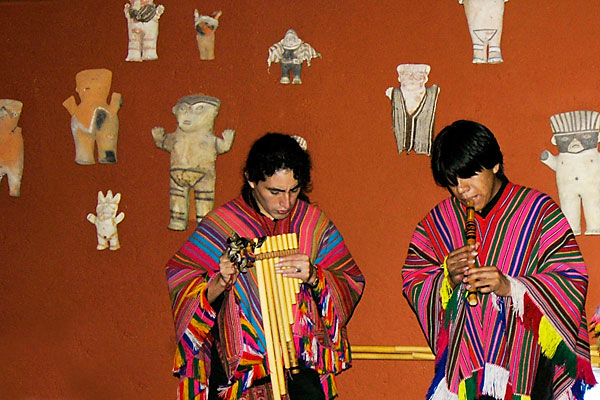
|
See the player on the right. I wanted to get one of those flutes for Darryl but not a tourist-toy one, a Real one. Consequently I bought that exact one right off this musician, so I would know it played right. This one was a bit beat up and he had a bag full of others and was happy enough for the cash. So we were both happy. This is a link to an Amazon.com cd with a selection of Peruvian pipe music. The ubiquitous Peruvian Pipe Band - they're Everywhere playing, you know, that song, the same song they actually play in Peru for the tourists. The cd above has a slightly different flavor but the same instrumentation. |
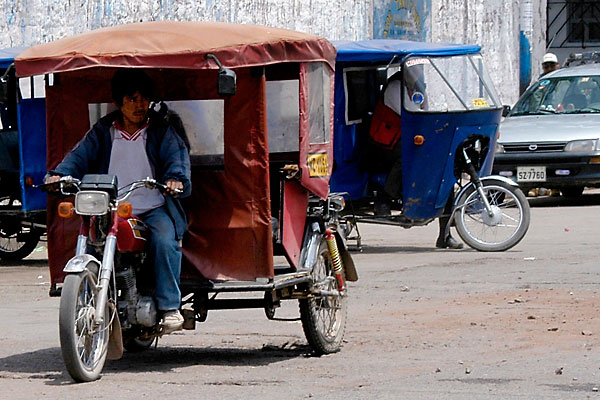
|
Local transportation. The guide who drove me to the train picked me up the next morning in a huge black thundering suv. From one of the first pictures you can see where we had traveled through the Sacred Valley. There are two routes – one through the mountains and another by the river Vilcanota. On the way in we took the mountain road and now we're following the river back. |
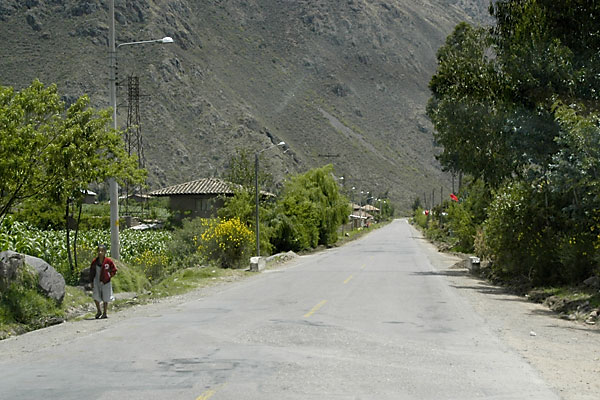
|
Notice the red flags on the right. This area is dense with crops, mostly corn, residential and commercial construction, and tourists too so there are many workers always about. The red flag means you can go to that house and refresh yourself with a nice glass of chicha. Uwww, can I try that? Sure. |
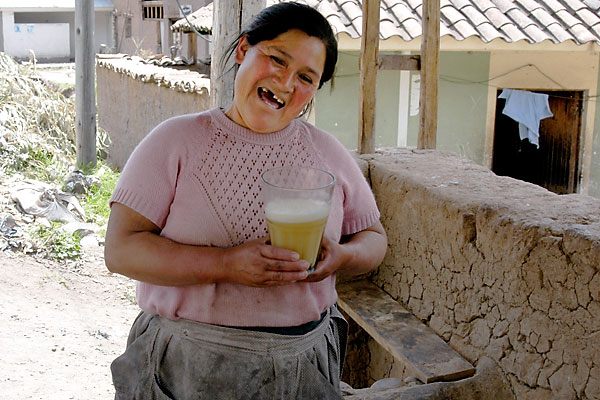
|
So we stop and mama-san brings us a glass. Chicha is made, basically, by taking fresh corn off the cob, putting it in a barrel with water and then, five or ten days later, scooping out the fermenting liquid and drinking it. The alcohol content is very light due to the short brewing time, just a percent or two, and men can sit around for hours playing cards and drinking glass after glass of chicha. It was very flavorful and I drank several swallows. Then the guide finished the glass in one long happy gulp. They say it is very nourishing... Here is an amusing effort at a recipe for chicha. |
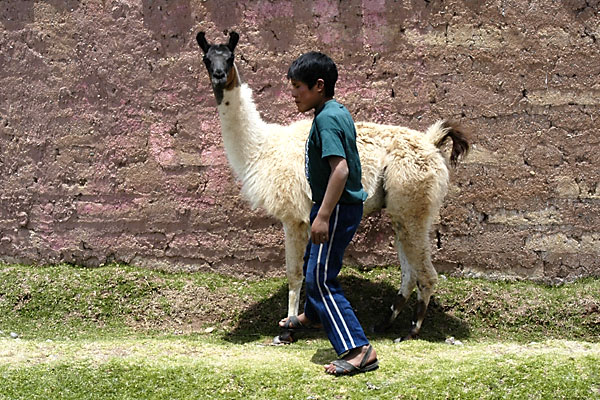
|
Llama! |
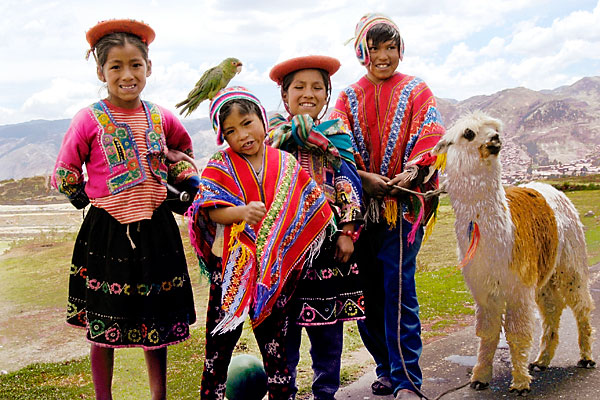
|
Looks like cute-as-pie kids, and they are, but this is big business. Kids dressed in local garb with their baby llama and colorful parrot will, everywhere and at the most unexpected moments, rush into your picture, smiling, with the drill down pat. Click-HandOut. Like that. |
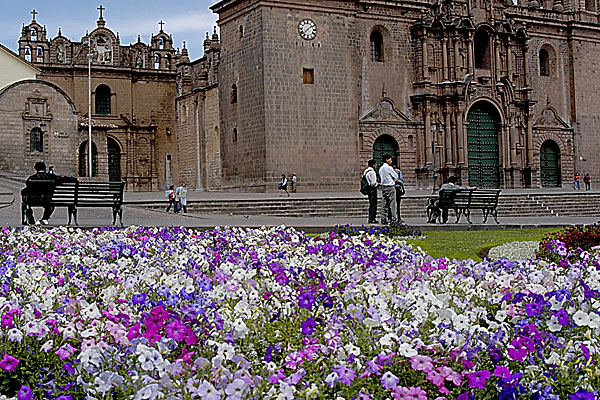
|
Throughout the day when you return to your hotel in Cusco, and I think this is true at all the hotels, you will be presented with a tea made from coca leaves, mate de coca, meant as an antidote to altitude sickness. And maybe it even works because I was entirely fine. So drink the tea! Just, according to the US Embassy don't bring any of it home! I very much enjoyed everything about Cusco - the gracious buildings, the colorful gardens and shops, the gorgeous surrounding mountains and the whole scene of travelers on the move. However at some point I was aggressively approached by street vendors just one too many times and I had to give up any hope of souvenir shopping. |
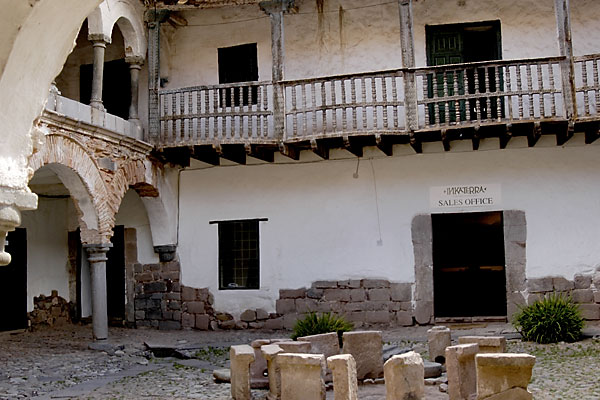
|
This building is one of two original colonial buildings still in use since earthquakes are frequent and often devastating. Inkaterra is situated here and it was really cool for a tourist office. Here is a website that has a lot of Cusco history. |
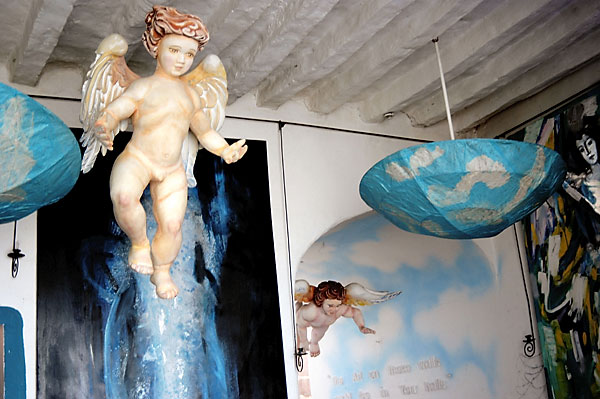
|
In the same complex is a new museum and between the Inkaterra office and the museum is this place. It is a restaurant, called The Fallen Angel. |
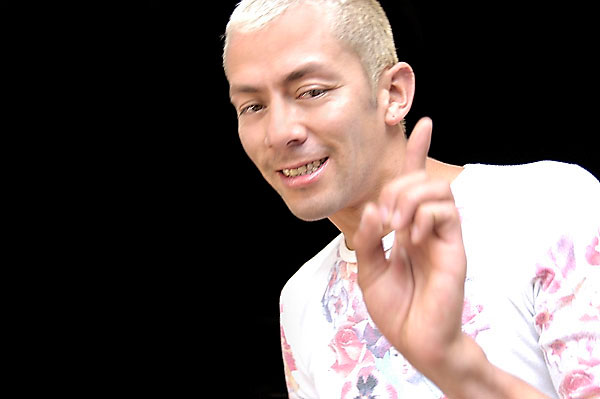
|
Here is the propriator. He has a vision and is building out the vision in the restaurant above. He's working on a book that will also express this vision. I had a lot of fun walking around in the physical manifestation of this guy's mind... Yeah, it was a little scary! |
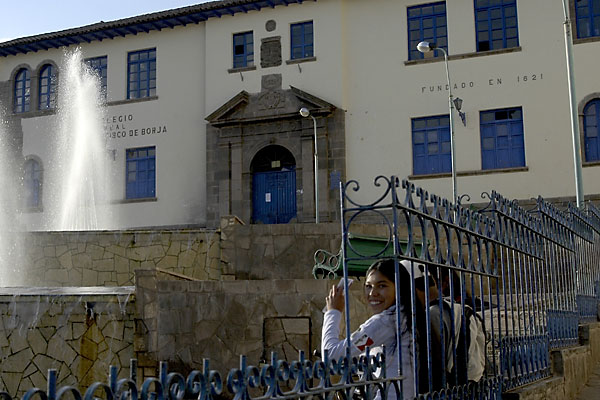
|
Schoolgirls, and because I loved her smile. |
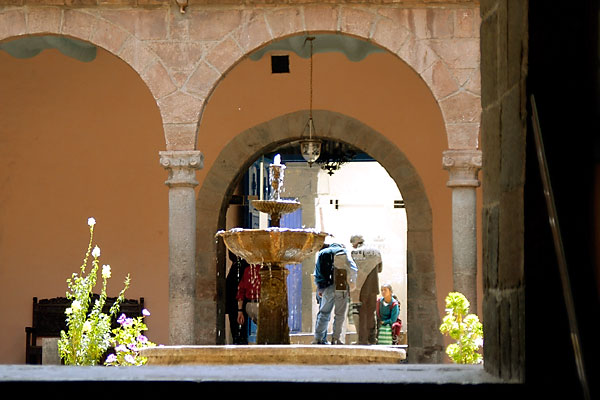
|
The plaza of my hotel. In the spirit of full disclosure, I should tell the story of my emergency house-call from a local doctor to give me an antihistamine shot since one minute I was perfectly fine and 8 minutes later I was covered in body welts so disgusting I knew I was having one massive allergic reaction. Through my clouded swollen eyes I only cared to notice that the doctor was taking the needle from a sealed package. He was great and within 30 minutes all was well. It was easy really, and now I am more confident than ever that you should go where you want, because hey, it's not going to kill you. The only thing I did differently that day from other days was eat a specialty dish made from one of the local grains, quinoa. You can buy quinoa right down the block at Whole Foods and I've been tempted to try it again as a test, but not That tempted! And my dear family and friends, I did not eat the guinea pig even though I could have. |
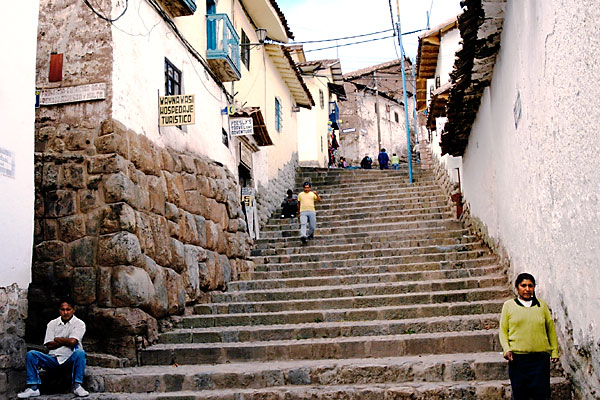
|
We're talking some serious climbing just to get around a few blocks. Oh yeah, steps. Go as soon as you can, while you're still young, while your knees still have some cartilage left and your lungs are pretty and pink and plump. |
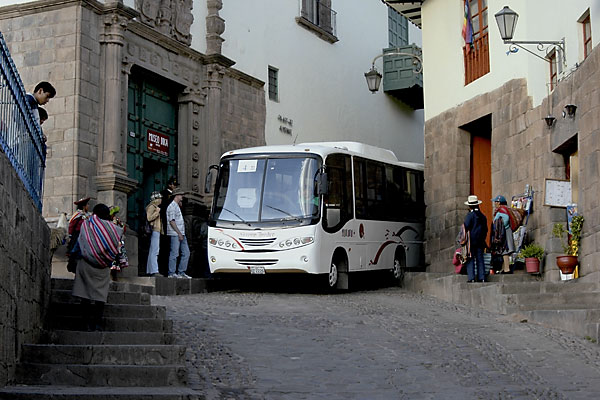
|
Streets built before Tour Buses... and local folk making their way. |
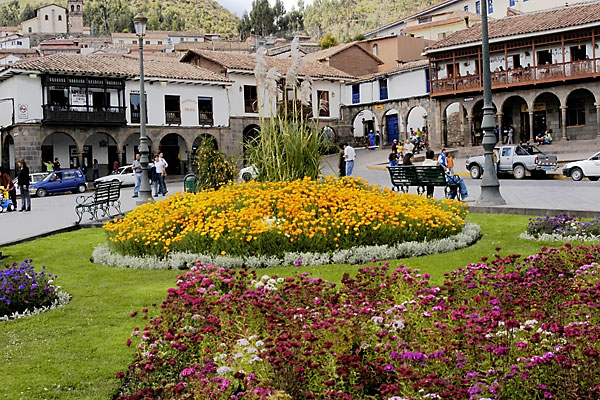
|
Note how it is steep even in the flattest part of town and on that note, I went to bed early for a crack-of-dawn wakeup call to begin the next phase of this trip - the Amazon Jungle. You can go directly to: Patagonia, the Chilean Fjords, Cusco and Machu Picchu, and the Amazon Rain Forest. |
| Home • Central and South America • Peru • '04 Nov: Machu Picchu |
© 2014 • WhereTheHeckIsMom.com